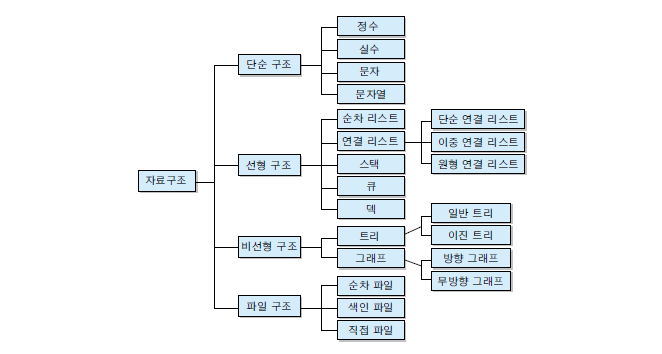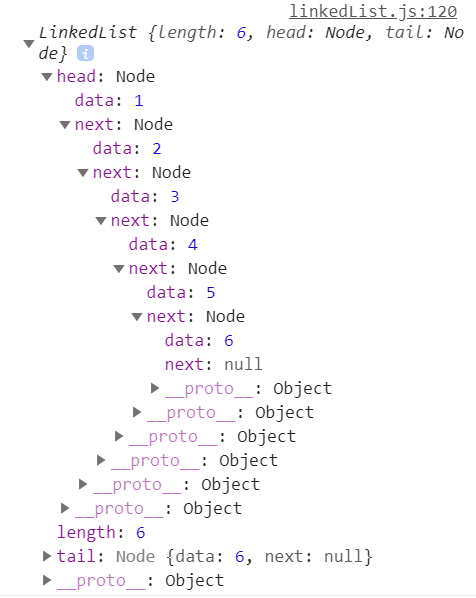공부를 위해 정리한 자료이므로 틀린 부분이 있을 수 있습니다. 그런 경우 댓글로 말씀해주시면 감사하겠습니다.
자료구조

- 자료구조 : 데이터의 표현 및 저장 방법
- 알고리즘 : 저장된 데이터를 처리하는 과정
즉, 자료구조를 알아야 알고리즘을 배울 수 있다.
연결 리스트(Linked List)
- 여러 개의 node로 이루어져 있는 리스트
- 노드는 데이터와 다음 노드의 주소로 구성되어 있음
- 데이터 추가/삭제/검색이 가능해야 함
단순 연결 리스트
- 다음 노드의 주소만을 가지는 연결 리스트
- 탐색 시 첫 노드에서부터 시작해서 최악의 경우 모든 노드를 검색해야하기 때문에, 시간 복잡도가
O(n)
이중 연결 리스트
- 다음 노드와 이전 노드의 주소를 가지는 연결 리스트
- 양방향 탐색 가능
- 이전 노드를 지정하기 위한 변수가 하나 더 필요하므로 메모리를 더 많이 사용
- 구현이 조금 더 복잡해짐
원형 연결 리스트
- 마지막 노드가 첫 번째 노드를 가리키게 하는 리스트
단순 연결 리스트 구현
zerocho님 블로그의 연결 리스트 구현 코드를 바탕으로 구현하였다.
- 마지막 노드의 주소를 가리키는
this.tail추가 - add/addToTail/remove/search/contains 구현
let LinkedList = (function () {
function LinkedList() {
this.length = 0; // 노드의 개수
this.head = null; // 첫 노드의 주소
this.tail = null; // 마지막 노드의 주소
}
function Node(data) {
this.data = data; // 데이터
this.next = null; // 다음 노드의 주소
}
LinkedList.prototype.addToTail = function (value) { // 마지막 노드에 데이터 삽입
let node = new Node(value);
let current = this.tail;
if (!current) { // 현재 아무 노드도 없으면
this.head = node; // head에 새 노드를 추가
this.tail = node; // tail에 새 노드를 추가
this.length++;
return node;
} else { // 이미 노드가 있으면
this.tail.next = node; // 마지막 노드의 next에 추가할 노드를 넣어준다.
this.tail = node; // 추가할 노드를 tail로 설정한다.
this.length++;
return node;
}
};
LinkedList.prototype.add = function (position, value) { // 데이터 삽입 (추가할 인덱스, 추가할 데이터)
let current = this.head; // 첫 번째 노드
let before;
let node = new Node(value);
let count = 0;
if (position === 0) { // 맨 앞에 삽입할 경우
node.next = this.head;
this.head = node;
this.length++;
return node;
}
// 아닌 경우 position 찾기
while (count < position) {
before = current;
count++;
current = current.next;
}
// 원래 가리키고 있던 다음 노드의 값을 변경
node.next = before.next; // 이전 노드가 가리키는 주소를 추가할 노드의 다음 노드로 설정
before.next = node; // 추가할 노드가 가리키는 주소를 원래 이전노드가 가리키던 노드 주소로 설정
this.length++;
return node;
}
LinkedList.prototype.search = function (position) {
let current = this.head;
let count = 0;
if (position >= this.length) {
return undefined;
}
if (count < position) {
current = current.next;
count++;
}
return current.data;
};
LinkedList.prototype.remove = function (position) {
let current = this.head;
let before;
let remove;
let count = 0;
if (position === 0) { // 첫 번째 노드를 삭제하면
remove = this.head;
this.head = this.head.next; // this.nead를 두 번째 노드로 교체
this.length--;
return remove;
} else { // 그 외 다른 노드를 삭제하면
if (count < position) {
before = current;
count++;
current = current.next;
}
remove = current; // 찾은 노드를 remove에 넣음
before.next = remove.next; // 삭제할 노드의 다음 노드를 이전 노드의 next로 만들어 줌
this.length--;
return remove;
}
};
LinkedList.prototype.contains = function (value) {
let current = this.head;
while (current) {
if (current.data === value) {
return true;
}
current = current.next;
}
return false;
}
return LinkedList;
})();
let list = new LinkedList();
list.addToTail(1);
list.addToTail(2);
list.addToTail(3);
list.addToTail(5);
console.log(list.length); // 4
list.add(3, 4);
list.addToTail(6);
console.log(list);
console.log(list.length); // 6
console.log(list.contains(7)); // false
위 코드의 결과

